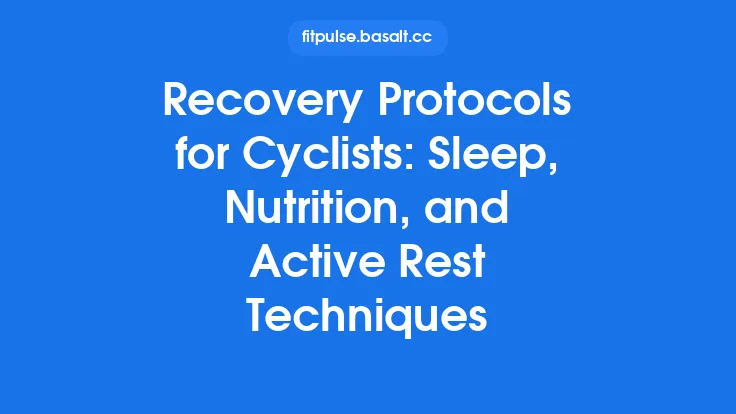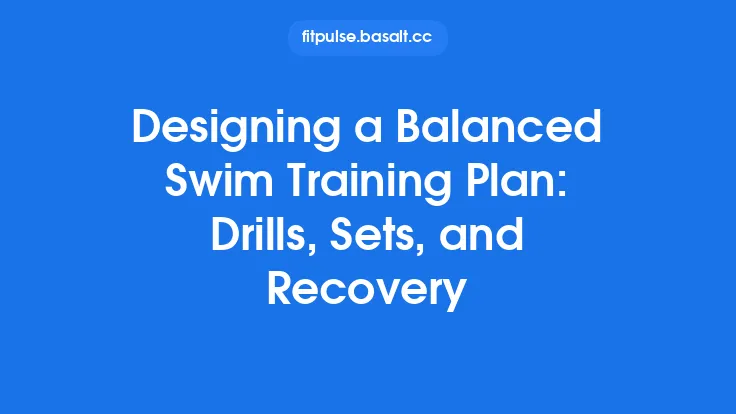Cycling is often perceived as a sport that lives and dies on the bike, but the truth is that the most successful riders spend a significant amount of time off the saddle. While mileage, power output, and aerodynamics dominate race day conversations, the foundation that allows a cyclist to generate power efficiently, stay injury‑free, and recover quickly lies in the body’s flexibility and core stability. By incorporating targeted cross‑training sessions that develop these qualities, cyclists can improve pedal stroke mechanics, enhance bike handling, and extend the longevity of their careers.
Why Flexibility Matters for Cyclists
Flexibility is more than just the ability to touch your toes; it is the capacity of muscles, tendons, and joint capsules to move through their full range of motion (ROM) without pain or compensation. For cyclists, adequate flexibility influences several performance‑critical factors:
| Area | Impact of Good Flexibility |
|---|---|
| Pedal Stroke Efficiency | A full ROM in the hip flexors, hamstrings, and calves allows a smoother transition from the power phase (downstroke) to the recovery phase (upstroke), reducing dead spots. |
| Bike Fit Tolerance | Even with an optimal bike fit, the body must be able to assume and maintain the required position for long periods. Tight muscles can force micro‑adjustments that increase aerodynamic drag and fatigue. |
| Handling and Control | Flexible shoulders, thoracic spine, and hips enable quick body movements needed for cornering, sprinting, and navigating technical terrain. |
| Injury Prevention | Restricted ROM often leads to compensatory patterns that overload joints and soft tissues, contributing to overuse injuries such as iliotibial band syndrome or lower back strain. |
| Recovery | Stretching promotes circulation, helping to clear metabolic waste products and deliver nutrients to fatigued muscles. |
Because cycling is a repetitive, low‑impact activity, the body can become “locked in” to a limited set of movement patterns. Regular flexibility work breaks this monotony, keeping the musculoskeletal system adaptable.
Core Stability: The Hidden Engine
The core—comprising the deep abdominal muscles (transversus abdominis, internal and external obliques), lumbar multifidus, diaphragm, and pelvic floor—acts as a rigid yet mobile platform from which the limbs generate force. In cycling, the core performs three essential roles:
- Force Transfer – Power generated by the legs must travel through the pelvis and torso before reaching the pedals. A stable core minimizes energy loss, allowing more of the leg’s output to become forward propulsion.
- Postural Control – Maintaining a steady, aerodynamic position while absorbing road vibrations requires constant micro‑adjustments from the core muscles.
- Breathing Efficiency – A well‑coordinated diaphragm and abdominal wall support deep, rhythmic breathing, which is crucial during long endurance rides and high‑intensity intervals.
Research consistently shows that cyclists with higher core endurance scores produce greater peak power and sustain higher intensities before fatigue sets in. Moreover, a robust core reduces the strain on the lumbar spine, a common site of discomfort for riders who spend hours in a flexed posture.
Designing a Balanced Cross‑Training Routine
A well‑structured cross‑training program for cyclists should address both flexibility and core stability while respecting the primary cycling workload. The following principles guide the design:
| Principle | Practical Application |
|---|---|
| Periodicity | Allocate 2–3 sessions per week, each lasting 30–45 minutes, spaced to avoid consecutive high‑intensity bike days. |
| Specificity | Choose movements that mimic the hip, knee, and spinal positions experienced on the bike. |
| Progressive Overload | Gradually increase stretch duration, range, or core load (e.g., from static holds to dynamic planks) every 2–3 weeks. |
| Recovery Integration | Pair flexibility work with active recovery rides or low‑intensity spin‑outs to enhance circulation without adding stress. |
| Individualization | Assess each rider’s ROM limitations and core deficits; tailor exercise selection accordingly. |
A typical weekly layout might look like:
- Monday: Light spin (60 min) + 15 min post‑ride static stretching (hamstrings, hip flexors, thoracic spine)
- Wednesday: Dedicated flexibility + core session (45 min)
- Friday: Moderate ride (90 min) + 10 min dynamic mobility drills during warm‑up
- Saturday: Long endurance ride (2–4 h) – no additional cross‑training to preserve glycogen
- Sunday: Rest or active recovery (easy swim/yoga) focusing on full‑body mobility
Key Flexibility Exercises for the Road and Trail
Below is a curated list of stretches that target the most restrictive areas for cyclists. Perform each stretch 2–3 times per side, holding for 30–60 seconds, and repeat 2–3 cycles per session.
1. Hip Flexor & Quadriceps Stretch (Lunge with Spinal Twist)
- Setup: From a standing position, step one foot back into a reverse lunge, keeping the front knee over the ankle.
- Action: Gently tuck the pelvis under, feeling a stretch in the rear hip flexor. Add a thoracic rotation by reaching the opposite arm toward the ceiling.
- Why: Counteracts the prolonged hip flexion during seated riding and improves pelvic stability.
2. Hamstring & Calf Complex (Supine Hamstring Pull)
- Setup: Lie on your back, loop a strap around the ball of one foot, and keep the leg straight.
- Action: Pull the leg toward you while keeping the hips grounded. For added calf stretch, flex the foot so the toes point upward.
- Why: Enhances the range needed for a full pedal stroke and reduces tension that can pull on the lower back.
3. Piriformis & Gluteal Release (Figure‑Four Stretch)
- Setup: Sit on the floor, cross the right ankle over the left knee, forming a “4”.
- Action: Gently press the right knee down while leaning forward, feeling a stretch deep in the glute.
- Why: Addresses tight glutes that can limit hip extension and cause knee tracking issues.
4. Thoracic Extension on Foam Roller
- Setup: Place a foam roller horizontally under the upper back, hands behind the head.
- Action: Slowly roll from T1 to T12, pausing at tight spots for 20–30 seconds.
- Why: Improves upper‑back mobility, essential for maintaining an aerodynamic position without compromising breathing.
5. Ankle Dorsiflexion Mobilization (Wall Ankle Stretch)
- Setup: Stand facing a wall, place the foot a few inches away, knee bent.
- Action: Drive the knee toward the wall while keeping the heel planted; the goal is to touch the wall with the knee without the heel lifting.
- Why: Increases ankle ROM, allowing a more efficient pedal stroke and reducing strain on the Achilles tendon.
Core Stability Drills Tailored to Cycling
Core work for cyclists should emphasize endurance, anti‑rotation, and the ability to maintain tension under dynamic conditions. Below are progressive drills, grouped by difficulty.
Beginner Level (Foundation)
| Exercise | Sets/Reps | Key Cue |
|---|---|---|
| Dead Bug (with or without light dumbbells) | 3 × 10 per side | Keep the low back pressed into the floor; move slowly. |
| Plank on Elbows | 3 × 30–45 s | Engage the glutes and maintain a neutral spine. |
| Side‑Plank (Knees Bent) | 3 × 20–30 s per side | Avoid sagging hips; keep the line from shoulder to knee straight. |
Intermediate Level (Dynamic Control)
| Exercise | Sets/Reps | Key Cue |
|---|---|---|
| Bird‑Dog (with band resistance) | 3 × 12 per side | Extend opposite arm and leg while keeping hips level. |
| Standing Pallof Press (cable or band) | 3 × 12 per side | Resist rotation; keep the torso upright. |
| Swiss Ball Roll‑Out | 3 × 8–10 | Initiate movement from the shoulders, not the hips. |
Advanced Level (Cyclist‑Specific)
| Exercise | Sets/Reps | Key Cue |
|---|---|---|
| Weighted Front Plank with Leg Lift | 3 × 8–10 lifts per leg | Maintain a rigid torso; avoid hip drop. |
| Single‑Leg Romanian Deadlift (Bodyweight or Light Kettlebell) | 3 × 10 per leg | Hinge at the hips, keep the core braced to prevent rotation. |
| Cyclist‑Specific “Bike‑Out” (Suspended Core Trainer) | 3 × 30 s | Simulate the forward lean of a road bike while holding a suspended position. |
Progression Tips:
- Increase hold times by 5–10 seconds before adding load.
- Incorporate unstable surfaces (e.g., BOSU, balance discs) once basic stability is mastered.
- Combine core drills with low‑intensity pedal rotations on a trainer to reinforce transferability.
Integrating Flexibility and Core Work into Your Weekly Plan
The goal is to make cross‑training a seamless part of the overall training load, not an isolated “extra.” Here’s a step‑by‑step integration method:
- Map Your Primary Cycling Sessions – Identify high‑intensity days (intervals, hill repeats) and low‑intensity days (endurance rides).
- Allocate Recovery Windows – Place flexibility sessions on the day after a hard ride, using them as active recovery. Core sessions can be slotted on moderate days when the nervous system is not overly taxed.
- Combine Warm‑Up Mobility with Core Activation – During the 10‑minute warm‑up before a ride, include dynamic hip circles, leg swings, and a 30‑second plank series. This primes the core without adding a separate session.
- Post‑Ride Stretching Routine – Immediately after the ride, perform a concise static stretch circuit (5–6 movements) to capitalize on the muscles’ warm state.
- Dedicated “Cross‑Training Day” – Once per week, schedule a 45‑minute session that alternates 20 minutes of flexibility work with 20 minutes of core drills, ending with a brief cool‑down.
- Track Subjective Metrics – Use a simple log (e.g., “tight hips: 2/5”, “core fatigue after ride: 1/5”) to monitor how the cross‑training influences perceived effort and comfort on the bike.
Monitoring Progress and Adjusting Load
Because flexibility and core stability are qualitative in nature, objective tracking helps ensure continued improvement.
| Metric | How to Measure | Target Progression |
|---|---|---|
| Hip Flexor ROM | Supine Thomas test or goniometer measurement of hip extension angle | +5° over 8 weeks |
| Hamstring Flexibility | Straight‑leg raise test (degrees) | +10° over 6 weeks |
| Core Endurance | Plank hold time, side‑plank hold time | +15 seconds per 2 weeks |
| Anti‑Rotation Strength | Pallof press distance (inches) or band tension level | Increase band resistance by one level every 3 weeks |
| Subjective Comfort | Rider rating of “tightness” after rides (1–10) | Decrease by 2 points after 4 weeks |
If any metric plateaus for more than three weeks, consider:
- Increasing Stretch Duration – Add 10 seconds to each hold.
- Modifying Load – For core work, shift from bodyweight to light external resistance.
- Altering Frequency – Add a brief 10‑minute mobility burst during a mid‑week ride.
Common Pitfalls and How to Avoid Them
| Pitfall | Why It Happens | Corrective Action |
|---|---|---|
| Static Stretching Before Hard Efforts | Reduces muscle spindle activity, temporarily decreasing power output. | Reserve static stretches for post‑ride or dedicated flexibility days; use dynamic mobility before intense rides. |
| Neglecting the Opposite Side | Over‑emphasis on the dominant leg or side leads to asymmetry. | Perform all unilateral stretches and core drills on both sides, even if one feels “tighter.” |
| Holding the Breath During Core Work | Increases intra‑abdominal pressure incorrectly, compromising spinal alignment. | Practice diaphragmatic breathing; exhale on the exertion phase of each core movement. |
| Using Too Much Load Too Early | Overloads the lumbar spine and can cause low‑back pain. | Start with bodyweight or light resistance; progress only when form remains flawless. |
| Skipping Warm‑Up | Muscles are less pliable, increasing injury risk. | Incorporate a 5‑minute general warm‑up (light cycling, jumping jacks) before any flexibility or core session. |
Frequently Asked Questions
Q: How often should I stretch if I’m training 15 hours a week on the bike?
A: Aim for at least three dedicated flexibility sessions (15–20 minutes each) plus brief post‑ride static stretches after every ride longer than 90 minutes. This balances time constraints with the need for regular ROM maintenance.
Q: Can core training replace traditional strength work for cyclists?
A: No. Core training complements but does not replace lower‑body strength work. It stabilizes the torso, allowing leg strength to be expressed more efficiently. A balanced program includes both core and leg‑focused strength sessions.
Q: Is yoga beneficial for cyclists?
A: Yes, when the practice emphasizes hip opening, thoracic extension, and core engagement. Choose classes that avoid excessive forward bending that could exacerbate a rounded back posture.
Q: How long does it take to see improvements in flexibility?
A: Most riders notice increased ROM within 4–6 weeks of consistent stretching (3–4 times per week). Significant gains in joint capsule flexibility may require 8–12 weeks.
Q: Should I stretch after every ride, even short ones?
A: Short rides (<60 minutes) can be followed by a brief 5‑minute stretch focusing on the most commonly tight areas (hip flexors, calves). Longer rides merit a more comprehensive routine.
By weaving flexibility and core stability work into the fabric of a cyclist’s training calendar, athletes create a resilient, efficient, and adaptable body. The result is not just smoother power delivery and better handling, but also a reduced risk of chronic discomfort and a longer, more enjoyable riding career. Consistency, progressive overload, and mindful integration are the three pillars that turn cross‑training from an optional add‑on into an essential component of elite cycling performance.





